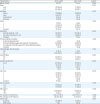1. Sopik V, Iqbal J, Rosen B, Narod SA. Why have ovarian cancer mortality rates declined? part I. Incidence. Gynecol Oncol. 2015; 138:741–749.


2. Torre LA, Islami F, Siegel RL, Ward EM, Jemal A. Global cancer in women: burden and trends. Cancer Epidemiol Biomarkers Prev. 2017; 26:444–457.


3. Smith BD, Smith GL, Hurria A, Hortobagyi GN, Buchholz TA. Future of cancer incidence in the United States: burdens upon an aging, changing nation. J Clin Oncol. 2009; 27:2758–2765.


4. Edwards BK, Howe HL, Ries LA, Thun MJ, Rosenberg HM, Yancik R, et al. Annual report to the nation on the status of cancer, 1973–1999, featuring implications of age and aging on U.S. cancer burden. Cancer. 2002; 94:2766–2792.


5. Yancik R, Ries LA. Cancer in older persons: an international issue in an aging world. Semin Oncol. 2004; 31:128–136.


6. Sheridan W, Scott T, Caroline S, Yvonne Z, Vanessa B, David V, et al. Breast cancer in young women: have the prognostic implications of breast cancer subtypes changed over time? Breast Cancer Res Treat. 2014; 147:617–629.


8. Oyer SL, Smith VA, Lentsch EJ. Reevaluating the prognostic significance of age in differentiated thyroid cancer. Otolaryngol Head Neck Surg. 2012; 147:221–226.


9. Smedley H, Sikora K. Age as a prognostic factor in epithelial ovarian carcinoma. Br J Obstet Gynaecol. 1985; 92:839–842.


10. Petignat P, Fioretta G, Verkooijen HM, Vlastos AT, Rapiti E, Bouchardy C, et al. Poorer survival of elderly patients with ovarian cancer: a population-based study. Surg Oncol. 2004; 13:181–186.


12. Pectasides D, Fountzilas G, Aravantinos G, Bamias A, Kalofonos HP, Skarlos D, et al. Epithelial ovarian carcinoma in younger vs older women: is age an independent prognostic factor? the Hellenic oncology cooperative group experience. Int J Gynecol Cancer. 2007; 17:1003–1010.


13. Sabatier R, Calderon B Jr, Lambaudie E, Chereau E, Provansal M, Cappiello MA, et al. Prognostic factors for ovarian epithelial cancer in the elderly: a case-control study. Int J Gynecol Cancer. 2015; 25:815–822.

14. Howlader N, Noone AM, Krapcho M, Miller D, Bishop K, Kosary CL, et al. SEER Cancer Statistics Review, 1975–2014 [Internet]. Bethesda, MD: National Cancer Institute;2017. cited 2018 Apr 2. Available from:
https://seer.cancer.gov/archive/csr/1975_2014/.
15. U.S. Cancer Statistics Working Group. United States cancer statistics: 1999–2011 incidence and mortality web-based report [Internet]. Atlanta, GA: Department of Health and Human Services, Centers for Disease Control and Prevention and National Cancer Institute;2014. cited 2014 Feb 2. Available from:
https://www.cdc.gov/cancer/uscs/.
16. Ramjaun A, Nassif MO, Krotneva S, Huang AR, Meguerditchian AN. Improved targeting of cancer care for older patients: a systematic review of the utility of comprehensive geriatric assessment. J Geriatr Oncol. 2013; 4:271–281.


17. Tew WP, Fleming GF. Treatment of ovarian cancer in the older woman. Gynecol Oncol. 2015; 136:136–142.


18. Tew WP. Ovarian cancer in the older woman. J Geriatr Oncol. 2016; 7:354–361.


19. Sperling C, Noer MC, Christensen IJ, Nielsen ML, Lidegaard Ø, Høgdall C. Comorbidity is an independent prognostic factor for the survival of ovarian cancer: a Danish register-based cohort study from a clinical database. Gynecol Oncol. 2013; 129:97–102.


21. Chan JK, Tian C, Monk BJ, Herzog T, Kapp DS, Bell J, et al. Prognostic factors for high-risk early-stage epithelial ovarian cancer: a gynecologic oncology group study. Cancer. 2008; 112:2202–2210.


22. Winter WE 3rd, Maxwell GL, Tian C, Carlson JW, Ozols RF, Rose PG, et al. Prognostic factors for stage III epithelial ovarian cancer: a gynecologic oncology group study. J Clin Oncol. 2007; 25:3621–3627.


23. Poole EM, Konstantinopoulos PA, Terry KL. Prognostic implications of reproductive and lifestyle factors in ovarian cancer. Gynecol Oncol. 2016; 142:574–587.


24. De Angelis R, Sant M, Coleman MP, Francisci S, Baili P, Pierannunzio D, et al. Cancer survival in Europe 1999–2007 by country and age: results of EUROCARE--5-a population-based study. Lancet Oncol. 2014; 15:23–34.


25. Balducci L, Extermann M. Management of cancer in the older person: a practical approach. Oncologist. 2000; 5:224–237.


26. Townsley CA, Selby R, Siu LL. Systematic review of barriers to the recruitment of older patients with cancer onto clinical trials. J Clin Oncol. 2005; 23:3112–3124.

27. Scher KS, Hurria A. Under-representation of older adults in cancer registration trials: known problem, little progress. J Clin Oncol. 2012; 30:2036–2038.


29. Freyer G, Geay JF, Touzet S, Provencal J, Weber B, Jacquin JP, et al. Comprehensive geriatric assessment predicts tolerance to chemotherapy and survival in elderly patients with advanced ovarian carcinoma: a GINECO study. Ann Oncol. 2005; 16:1795–1800.


31. Girre V, Falcou MC, Gisselbrecht M, Gridel G, Mosseri V, Bouleuc C, et al. Does a geriatric oncology consultation modify the cancer treatment plan for elderly patients? J Gerontol A Biol Sci Med Sci. 2008; 63:724–730.











 PDF
PDF Citation
Citation Print
Print




 XML Download
XML Download